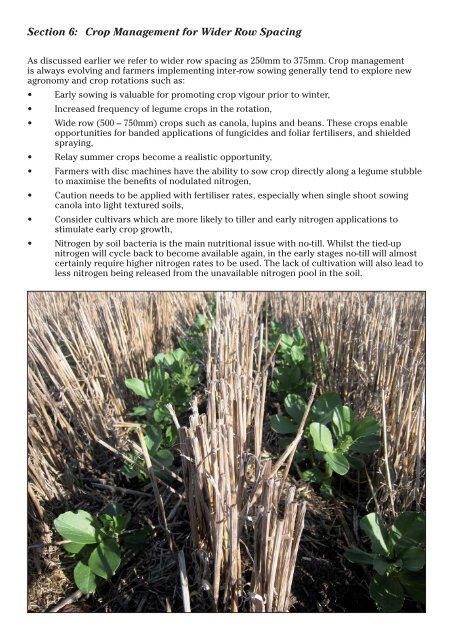Managing Stubble - Grains Research & Development Corporation
Managing Stubble - Grains Research & Development Corporation
Managing Stubble - Grains Research & Development Corporation
Create successful ePaper yourself
Turn your PDF publications into a flip-book with our unique Google optimized e-Paper software.
Section 6: Crop Management for Wider Row Spacing<br />
As discussed earlier we refer to wider row spacing as 250mm to 375mm. Crop management<br />
is always evolving and farmers implementing inter-row sowing generally tend to explore new<br />
agronomy and crop rotations such as:<br />
• Early sowing is valuable for promoting crop vigour prior to winter,<br />
• Increased frequency of legume crops in the rotation,<br />
• Wide row (500 – 750mm) crops such as canola, lupins and beans. These crops enable<br />
opportunities for banded applications of fungicides and foliar fertilisers, and shielded<br />
spraying,<br />
• Relay summer crops become a realistic opportunity,<br />
• Farmers with disc machines have the ability to sow crop directly along a legume stubble<br />
to maximise the benefits of nodulated nitrogen,<br />
• Caution needs to be applied with fertiliser rates, especially when single shoot sowing<br />
canola into light textured soils,<br />
• Consider cultivars which are more likely to tiller and early nitrogen applications to<br />
stimulate early crop growth,<br />
• Nitrogen by soil bacteria is the main nutritional issue with no-till. Whilst the tied-up<br />
nitrogen will cycle back to become available again, in the early stages no-till will almost<br />
certainly require higher nitrogen rates to be used. The lack of cultivation will also lead to<br />
less nitrogen being released from the unavailable nitrogen pool in the soil.

















